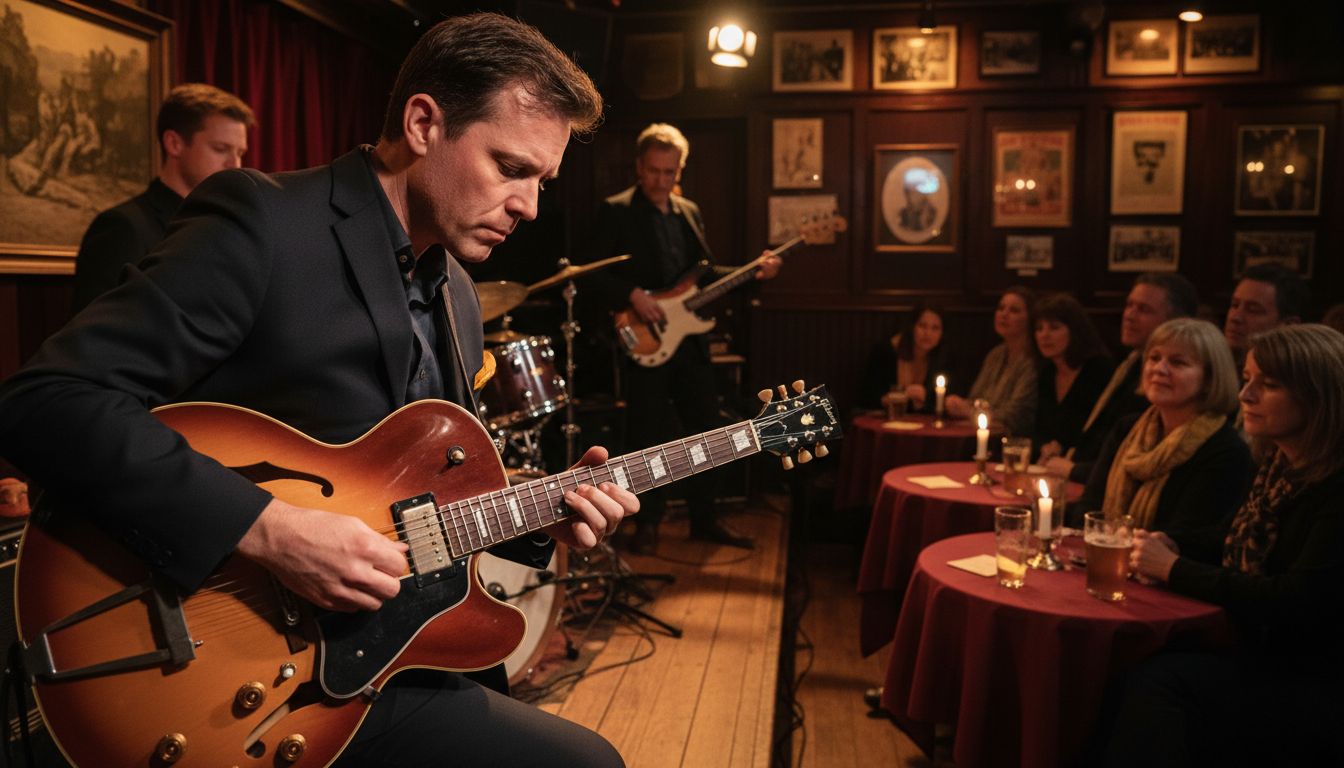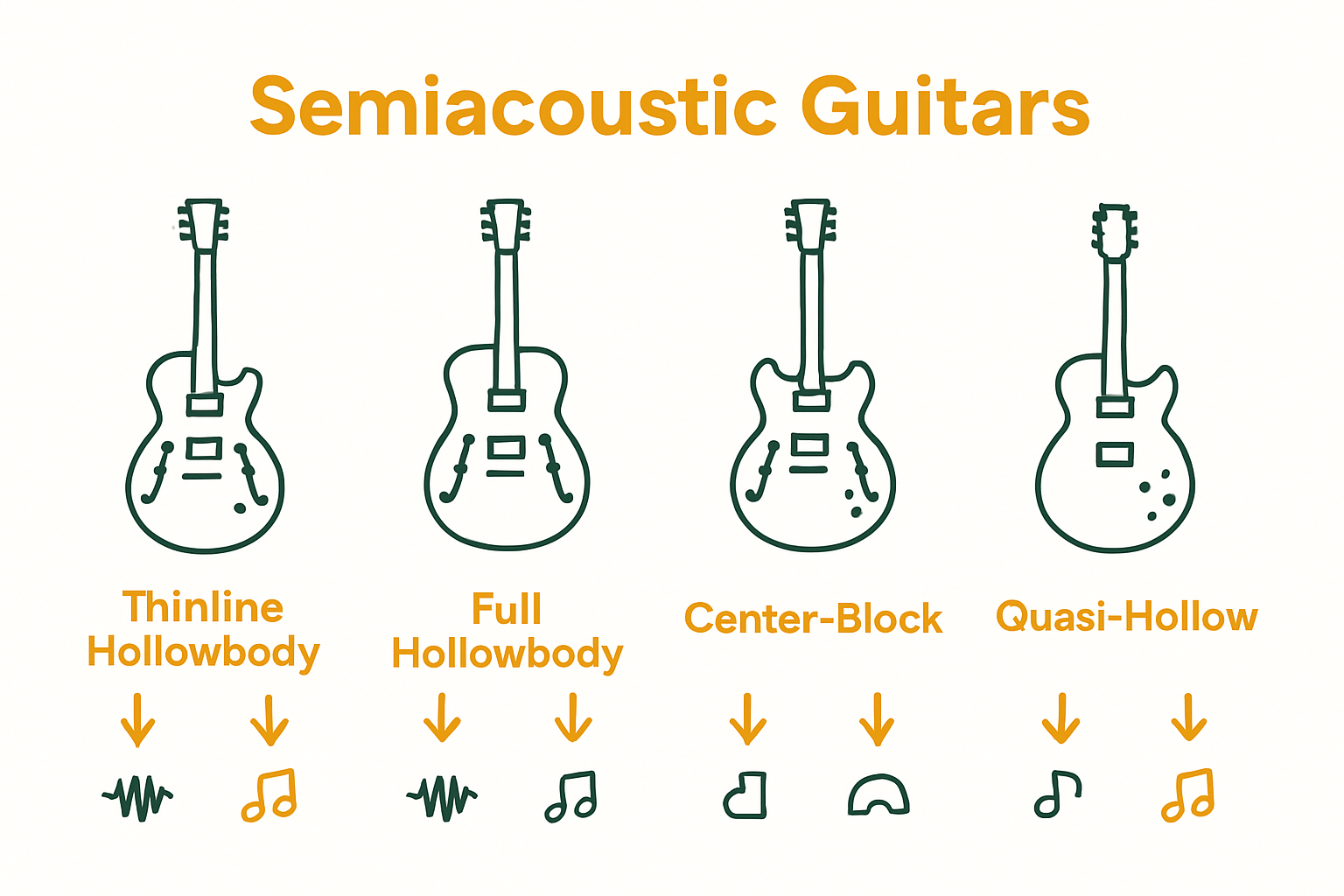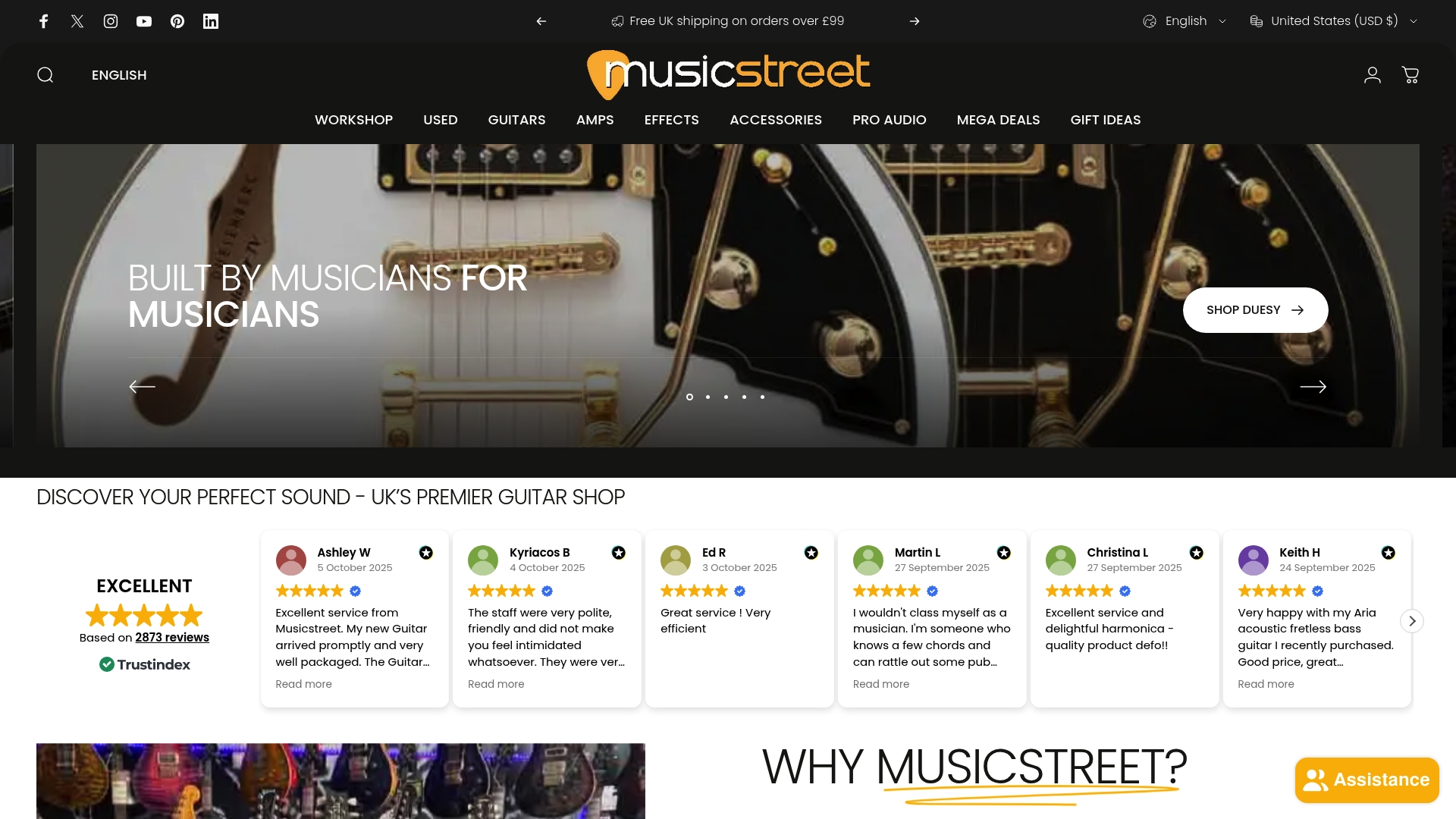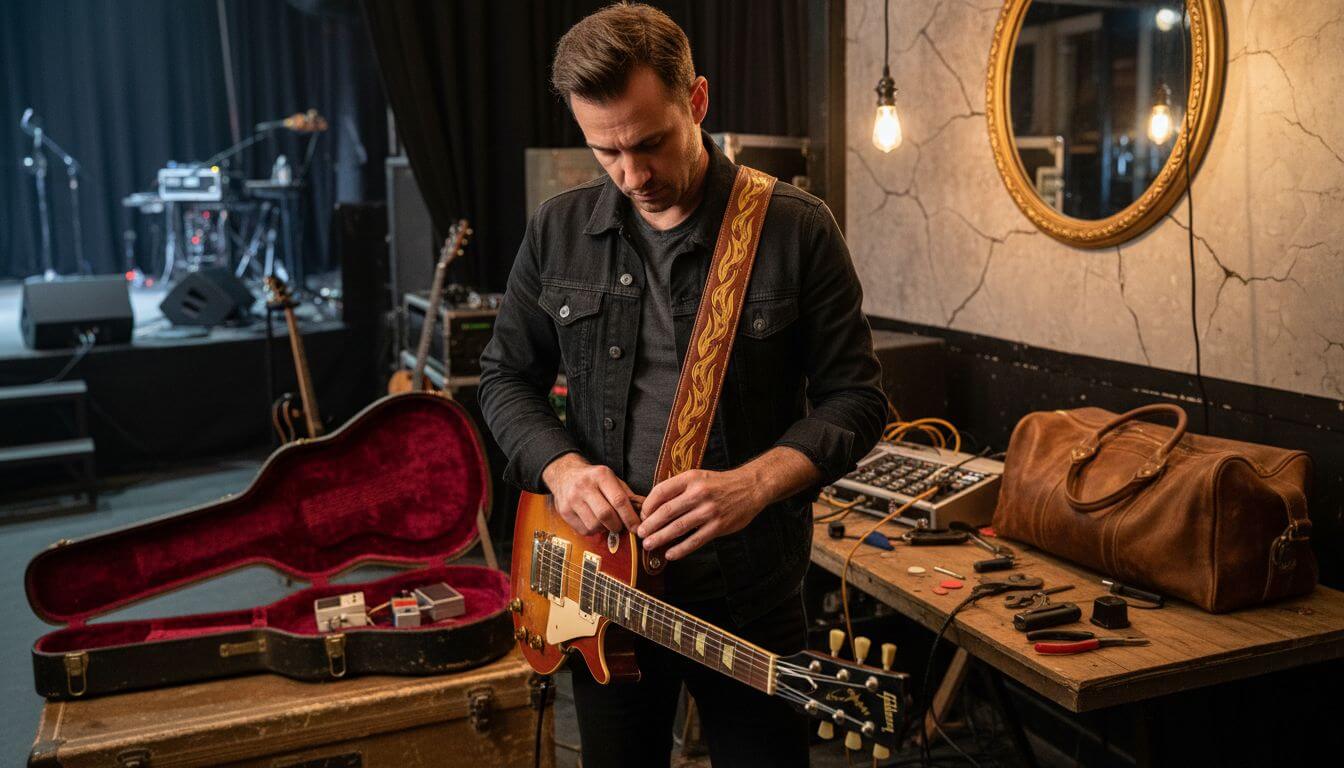Over 90 percent of british guitarists have experimented with more than one type of guitar in their journey for the perfect sound. As musicians push creative boundaries, the semiacoustic guitar has become an appealing choice for those who want the depth of an acoustic and the versatility of electric amplification. This guide helps you understand what sets the semiacoustic guitar apart, why it matters for british players, and how it can transform your musical experience.
Table of Contents
- Defining The Semiacoustic Guitar And Its Purpose
- Core Features And Sound Characteristics Explained
- Main Types Of Semiacoustic Guitars Compared
- Semiacoustic Vs Acoustic And Electric Guitars
- Buying, Playing, And Maintenance Essentials
Key Takeaways
| Point | Details |
|---|---|
| Hybrid Design | The semiacoustic guitar combines features of electric and acoustic guitars, offering versatility in sound. |
| Tonal Characteristics | It provides warm, organic tones with natural resonance, suitable for various music genres. |
| Buying Considerations | Key factors when purchasing include body construction, wood quality, and intended musical style. |
| Maintenance Practices | Regular cleaning, proper storage, and periodic professional setups are essential for longevity. |
Defining the Semiacoustic Guitar and Its Purpose
The semiacoustic guitar represents a fascinating hybrid instrument that bridges the sonic landscapes between traditional acoustic and electric guitars. According to research from eprints, this unique instrument is fundamentally an electric guitar featuring a hollow body, which provides musicians with a more resonant sound profile compared to solid-body electric guitars.
Unlike standard electric guitars, semiacoustic guitars are purposefully designed with acoustic characteristics that enhance their tonal complexity. As detailed by theses research, these instruments are specifically engineered to be amplified while retaining significant acoustic properties. This design approach allows guitarists to enjoy rich, nuanced sounds across multiple musical genres.
Key characteristics of semiacoustic guitars include:
- Partially hollow body construction
- Enhanced acoustic resonance
- Capability for electric amplification
- Versatile sound suitable for jazz, rock, and blues
The semiacoustic guitar’s unique design makes it an incredibly adaptable instrument. Whether you’re performing in an intimate jazz club or a large concert venue, these guitars offer musicians remarkable tonal flexibility and sonic depth that transcend traditional guitar limitations.
 Our guide to choosing the perfect Acoustic guitar for you can provide additional insights into selecting the right instrument for your musical journey.
Our guide to choosing the perfect Acoustic guitar for you can provide additional insights into selecting the right instrument for your musical journey.
Core Features and Sound Characteristics Explained
The semiacoustic guitar represents a remarkable fusion of acoustic and electric guitar technologies, offering musicians unprecedented sonic versatility. According to research from eprints, the instrument’s hollow body construction is fundamental to creating its distinctive resonant sound profile, which fundamentally differentiates it from traditional solid-body electric guitars.
Theses research highlights that semiacoustic guitars function as extraordinary hybrid instruments, capable of performing roles traditionally associated with both electric and acoustic guitars. This unique design enables musicians to explore a rich and expansive sound palette across multiple musical genres.
Key sound characteristics include:
- Warm, organic tonal qualities
- Enhanced mid-range frequencies
- Natural acoustic resonance
- Exceptional sustain and harmonic complexity
The structural design of semiacoustic guitars typically involves a central wooden block running through the body, with hollow wings that contribute to the instrument’s distinctive sonic signature. This innovative construction allows for remarkable feedback control while maintaining the rich, nuanced sound that musicians appreciate. 7 Types of Acoustic Guitar can provide additional context for understanding the broader guitar landscape and how semiacoustic models fit within it.
Musicians across jazz, blues, rock, and alternative genres appreciate semiacoustic guitars for their remarkable tonal flexibility. Whether plugged directly into an amplifier or played unplugged, these instruments offer a unique sound that bridges traditional musical boundaries, making them an essential tool for creative expression.
Main Types of Semiacoustic Guitars Compared
Semiacoustic guitars come in several distinctive variations, each offering unique tonal characteristics and design approaches. According to ICMP research, instruments like the Peerless Wizard represent a sophisticated thinline cutaway hollow body design, featuring a 17-inch wide laminated flame maple body that delivers a crisp and remarkably clear sound profile.
The primary categories of semiacoustic guitars include:
- Thinline Hollowbody Guitars: Featuring a slim profile with partial hollow construction
- Full Hollowbody Guitars: Completely hollow with no central wood block
- Center-Block Guitars: Featuring a solid wooden block running through the body’s centre
- Quasi-Hollow Guitars: Minimal internal chambering with enhanced resonance
Another notable example from ICMP documentation is the Ibanez AF57 Semi Hollow, which exemplifies the versatility within semiacoustic guitar design. These instruments are particularly popular among jazz, blues, and rock musicians seeking nuanced tonal complexity.
The structural variations significantly impact each guitar’s sonic characteristics. Thinline models offer improved feedback resistance, making them ideal for high-volume performances, while full hollowbody guitars provide deeper, more resonant acoustic qualities. Electric vs Acoustic Guitar can provide additional context for understanding how semiacoustic guitars bridge these traditional instrument categories. Ultimately, the choice depends on a musician’s specific playing style, genre preferences, and desired sound palette.

Semiacoustic vs Acoustic and Electric Guitars
The semiacoustic guitar represents a sophisticated hybrid instrument that elegantly bridges the sonic capabilities of acoustic and electric guitars. According to research from eprints, this unique instrument combines features of both traditional guitar types, offering musicians a resonant sound with exceptional amplification capabilities.
Key distinctions between guitar types include:
- Acoustic Guitars: Purely acoustic, rely on wooden body resonance
- Electric Guitars: Solid body, dependent on electronic signal amplification
- Semiacoustic Guitars: Partially hollow body, blend acoustic and electric characteristics
Theses research highlights that semiacoustic guitars function across multiple musical roles, providing a versatile sound palette that transcends traditional instrument boundaries. Unlike purely acoustic guitars, semiacoustic models can be plugged directly into amplification systems, while offering more natural acoustic resonance than standard electric guitars.
The structural nuances make semiacoustic guitars particularly compelling for musicians seeking tonal flexibility. Where acoustic guitars depend entirely on natural sound projection and electric guitars rely completely on electronic amplification, semiacoustic guitars offer a remarkable compromise. Classical Guitar vs. Acoustic Guitar can provide additional context for understanding these intricate musical instrument distinctions. Ultimately, the semiacoustic guitar emerges as a sophisticated solution for musicians who refuse to be constrained by traditional instrumental limitations.
Buying, Playing, and Maintenance Essentials
Purchasing a semiacoustic guitar requires careful consideration of multiple factors, including your musical style, budget, and technical requirements. According to ICMP documentation, educational institutions recommend models like the Peerless Wizard and Ibanez AF57 as excellent starting points for musicians exploring semiacoustic instruments.
Essential considerations when buying a semiacoustic guitar include:
- Body construction and wood quality
- Pickup configuration
- Neck profile and playability
- Budget range
- Intended musical genre
BIMM London highlights the importance of matching your semiacoustic guitar with appropriate amplification to maximise its sonic potential. Professional musicians recommend investing in a versatile amplifier that can handle the nuanced tonal characteristics of semiacoustic instruments.
Maintenance is crucial for preserving your instrument’s quality and performance. Regular practices should include:
- Cleaning the body and strings after each playing session
- Storing the guitar in a controlled environment
- Regular string replacement
- Professional setup every 12-18 months
- Monitoring humidity levels to prevent wood warping
Whether you’re a seasoned professional or an emerging musician, understanding the intricacies of semiacoustic guitar care will ensure your instrument remains in pristine condition. Benefits of Learning How to Play the Acoustic Guitar can provide additional insights into maintaining and enjoying your musical journey.
Discover Your Perfect Semiacoustic Sound with MusicStreet
Navigating the world of semiacoustic guitars can be overwhelming due to the variety of body types, tonal qualities and amplification options. This article highlights how semiacoustic guitars bridge the gap between acoustic resonance and electric versatility. If you are seeking an instrument that offers warm tones, excellent sustain and adaptability across genres you need expert advice and a carefully selected range to find the right guitar for your style and budget.

At MusicStreet.co.uk we understand these challenges and provide a premium collection of semiacoustic guitars including top models like the Peerless Wizard and the Ibanez AF57 Semi Hollow. Alongside detailed product descriptions and professional setup services at our Huntingdon store, you will gain confidence in your choice and maintain your instrument for years to come. Explore our unbeatable guides on choosing the perfect acoustic guitar and types of acoustic guitars to broaden your knowledge and make an informed decision.
Don’t settle for compromise when you can have the best of both worlds. Visit MusicStreet.co.uk today and experience firsthand how the right semiacoustic guitar can transform your musical expression. Take the next step towards unlocking the full potential of your sound now.
Frequently Asked Questions
What is a semiacoustic guitar?
A semiacoustic guitar is a hybrid instrument that combines elements of both acoustic and electric guitars, featuring a partially hollow body that allows for enhanced acoustic resonance while also being capable of electric amplification.
How does a semiacoustic guitar differ from an acoustic guitar?
Unlike acoustic guitars, which rely solely on wooden body resonance for sound production, semiacoustic guitars integrate both acoustic characteristics and electronic amplification, providing more tonal versatility.
What are the main types of semiacoustic guitars?
The main types include thinline hollowbody guitars, full hollowbody guitars, center-block guitars, and quasi-hollow guitars, each offering different sonic characteristics based on their construction and design.
How do I maintain my semiacoustic guitar?
To maintain your semiacoustic guitar, regularly clean the body and strings, store it in a controlled environment to prevent wood warping, replace strings as needed, and have a professional setup every 12-18 months.



Share:
Complete Guide to Custom Guitar Straps